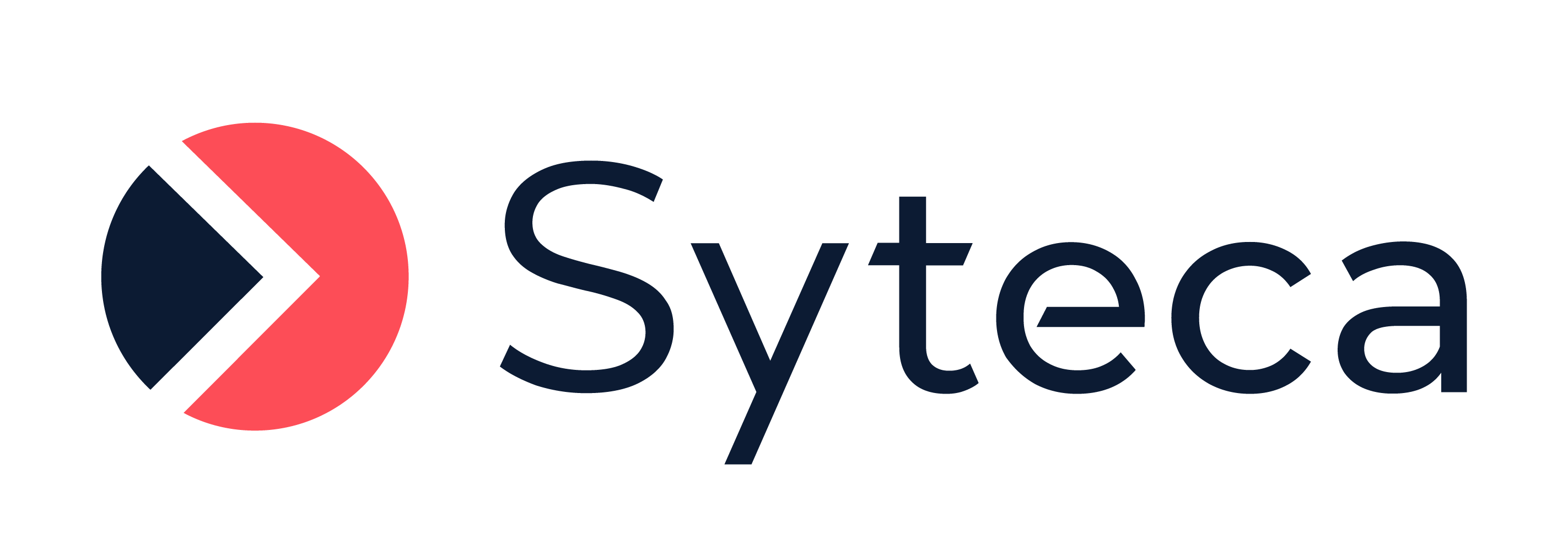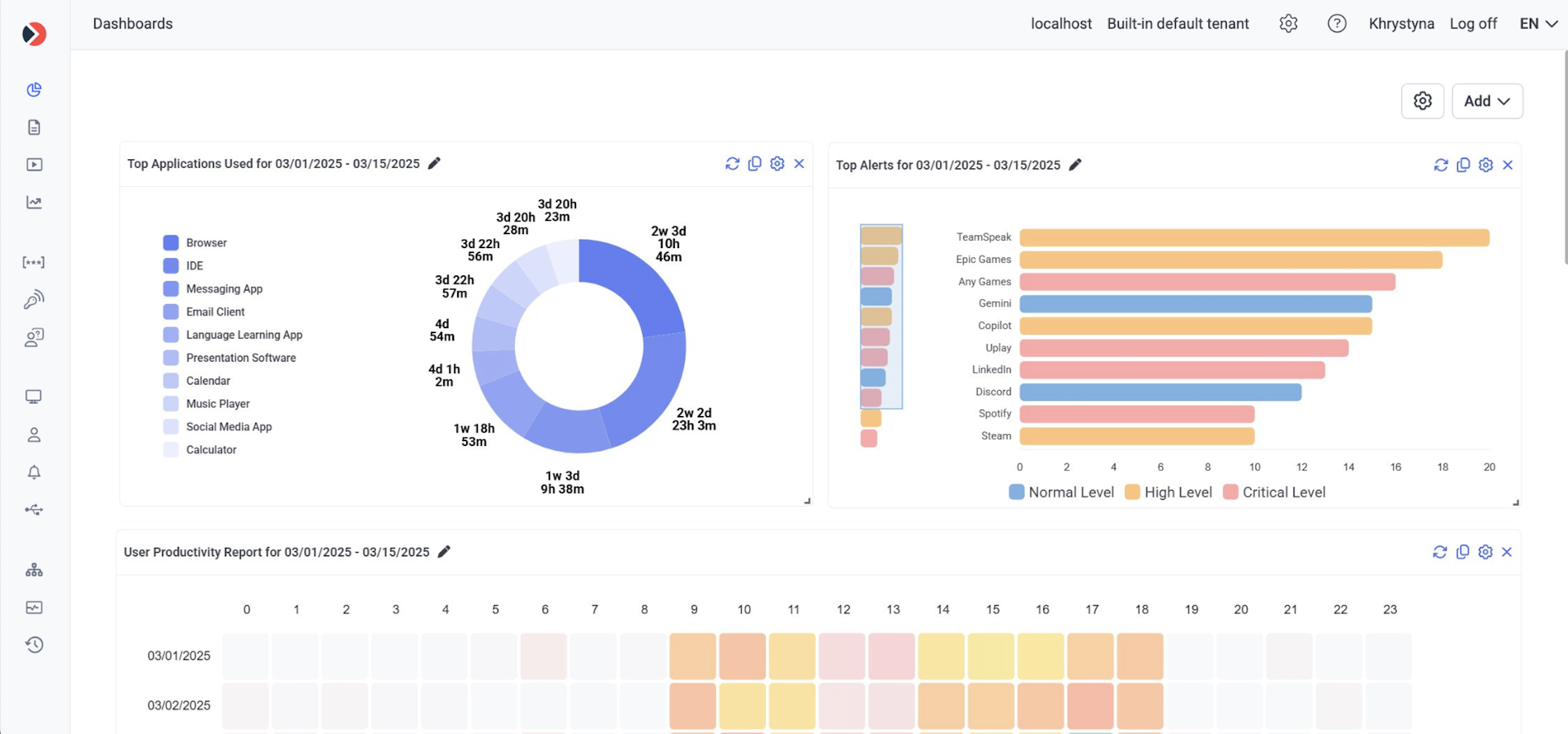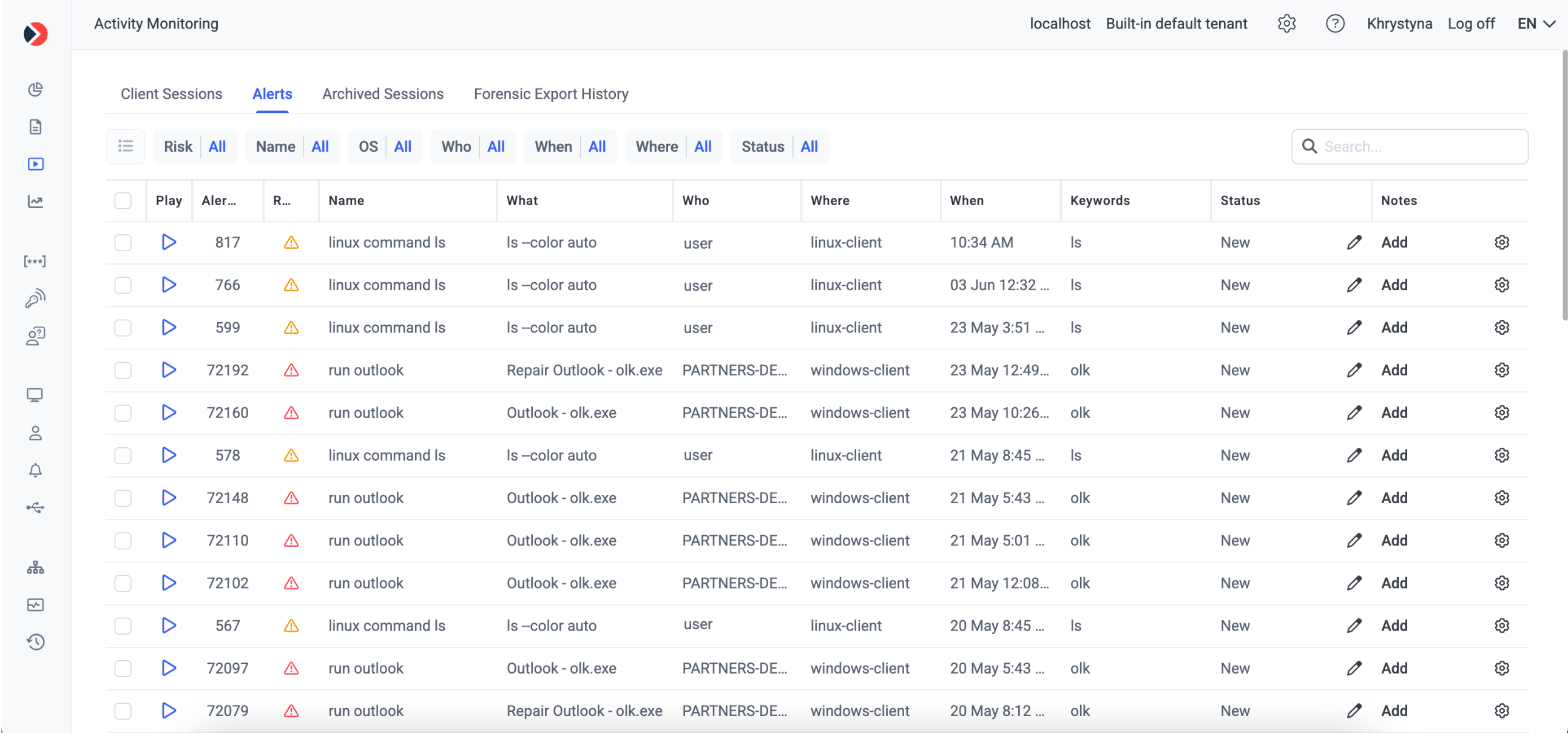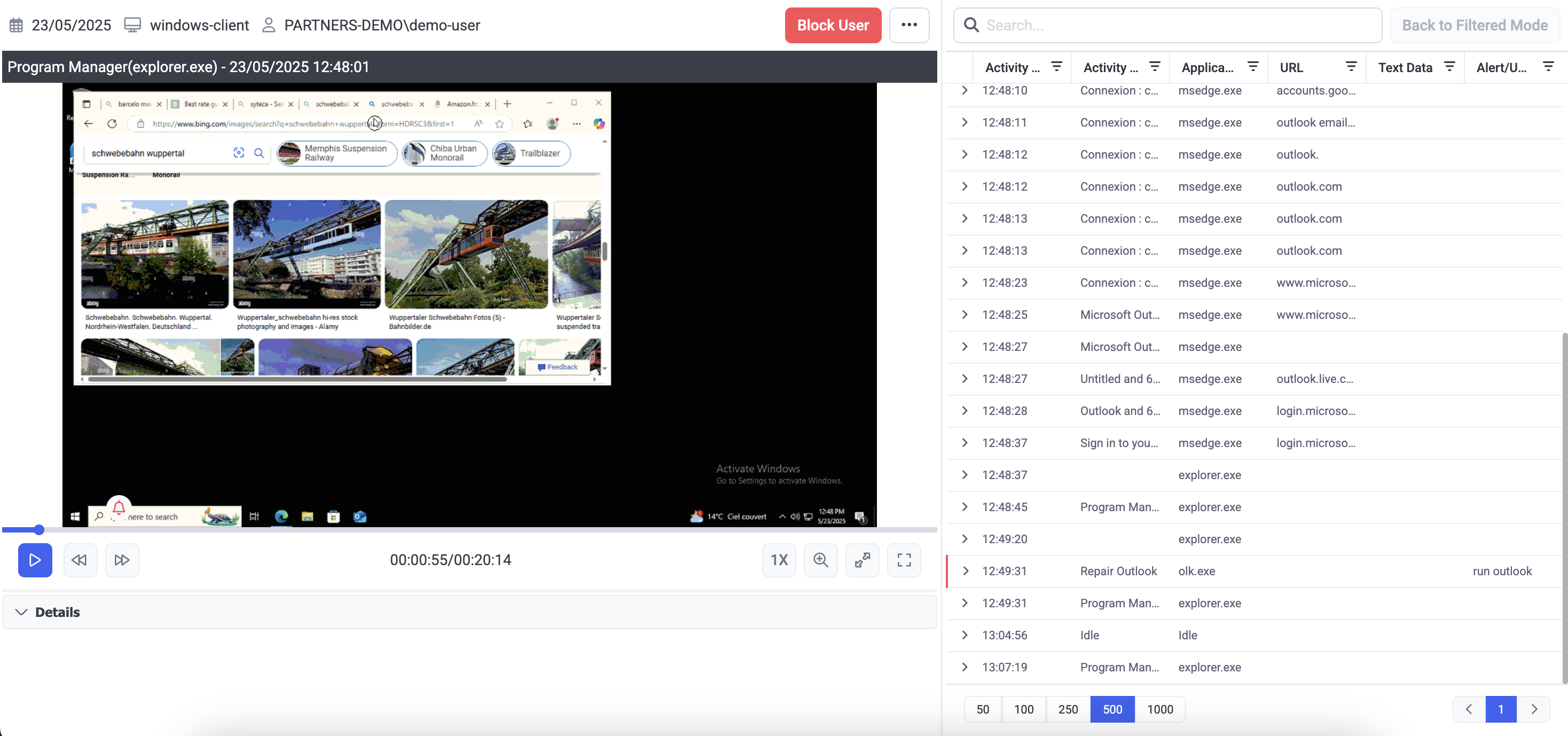
Overview

Syteca Dashboards
Track application usage, alert levels, and productivity trends with visual, real-time dashboards.

Syteca Dashboards

Alerts

Video Session Playback

Product video
Our Monitoring, Searching, and Reporting capabilities are highly advanced. We monitor and record all user actions, including keystrokes, active windows, and specific applications. The powerful search function allows you to easily find recorded sessions by metadata such as user, time, IP address, or specific activities. Additionally, we offer customizable reports that can be scheduled or generated on demand, helping to track productivity, detect anomalies, and ensure compliance. Also, we support a wide range of platforms (Windows, macOS, SE Linux / Linux, UNIX, VMware, AWS, Citrix, X Window, Wayland)
Syteca UAM main capabilities:
- User session recording: record user sessions in screen capture recording format with searchable text metadata and gain insights into sensitive interactions.
- Alerts and incident response: quickly get alerts on unwanted user activity such as unauthorized file access or improper use of privileges and respond instantly for rapid threat mitigation.
- Auditing and user activity reporting: generate reports on user activity, review security alerts, and assess user productivity to evaluate organizational security and compliance.
- Keystroke monitoring: enable keystroke monitoring to detect malicious and harmful activity, creating a detailed audit trail for forensic investigation and incident response.
- USB Device Management: control removable media usage to prevent data leaks.
- Pseudonymization: Protect personal data to ensure compliance.
Highlights
- Eliminate blind spots - Ensure no suspicious activity goes unnoticed with live on-screen activity monitoring and insightful metadata logging.
- Stop threats in time - Detect early signs of suspicious activity and block high-risk users or actions before they cause damage.
- Increase productivity - Leverage productivity insights to assess the efficiency of your workforce and pinpoint areas for improvement.
Details
Introducing multi-product solutions
You can now purchase comprehensive solutions tailored to use cases and industries.

Features and programs
Financing for AWS Marketplace purchases

Pricing
Vendor refund policy
Refund is considered via a request to the Sales team at aws-marketplace@ekransystem.com
How can we make this page better?

Legal
Vendor terms and conditions
Content disclaimer
Delivery details
64-bit (x86) Amazon Machine Image (AMI)
Amazon Machine Image (AMI)
An AMI is a virtual image that provides the information required to launch an instance. Amazon EC2 (Elastic Compute Cloud) instances are virtual servers on which you can run your applications and workloads, offering varying combinations of CPU, memory, storage, and networking resources. You can launch as many instances from as many different AMIs as you need.
Version release notes
New Features:
- [Management Tool Interface:] The Management Tool UI has a fresh new design theme (mostly the visual style, including the color scheme, but also the layout of some pages has also been partially modified) to improve the UX and the look & feel.
- [Password Management:] Syteca Web Connection Manager is now available for simplified use of secrets (as an alternative to the desktop version of Syteca Connection Manager) by launching them directly from the Password Management page (which also has a new layout) in the Management Tool, either in the browser (i.e. agentless PAM) or locally.
- [Monitoring Windows Clients:] The Sensitive Data Masking feature is now available to allow custom regex values to be defined so as to detect and mask sensitive clear text data (e.g. passwords, SSNs, credit card numbers, etc.) on Windows Client computers that is displayed in the Session Viewer (currently supported for: MS Word, MS Outlook (new and classic versions), Google Chrome, MS Edge, Notepad++).
- [Alerts:] The "Kill application" option is now also available for macOS Client computers (and is the same way as for Windows Clients).
- [Monitoring Linux Clients:] The Record user activity only on alert or USB monitoring rule triggering option is now also available to record user activity on Linux Client computers only in the specified time periods before and after alerts are triggered (in the same way as for Windows and macOS Clients).
Improvements:
- [Account Discovery:] A secret can now be used for remote password rotation when onboarding Active Directory accounts discovered (in the same way as for Windows local and Linux accounts).
- [Management Tool UI:] Translations have been updated for the Chinese (ZH) language localization.
- [Third-Party Products:] Various libraries that are used by Syteca have been updated to fix vulnerabilities identified (included OpenSSL for macOS and Linux Clients) - fixed.
Additional details
Usage instructions
Once the EC2 instance is launched, it could take up to 15 minutes for Syteca to be ready for use. There are three components preinstalled and configured:
- Syteca Application Server
- Syteca Management Tool
- Microsoft SQL Server
Accessing the Syteca Management Tool
To start using Syteca, access the Syteca Management Tool in one of the following ways:
- Via the EC2 instance: Connect to the EC2 instance via RDP. Then, use the shortcut on the desktop or enter the following address in the browser: https://syteca-srv/syteca/
- Outside of the EC2 instance: Allow the 443 port (HTTPS) in the security group settings and use the public name or IP address of the instance (e.g., https://<public_ip_dns>/syteca/).
Use the credentials of the default administrator to log in to the Management Tool:
- Username: admin
- Password: Syteca-<EC2 instance ID> (e.g., "Syteca-i-0eafddd4122cdb47e")
Installing Agents
In the Syteca Management Tool, you can download the Syteca agent and install it on the endpoints you wish to monitor. For more information on how to install agents and use Syteca, refer to Syteca's knowledge base: https://docs.syteca.com/view
Accessing the SQL Server
Use the following credentials to access the SQL Server:
- Username: syteca
- Password: <EC2 instance ID> (e.g., "i-0eafddd4122cdb47e")
Storage Usage
There are two additional disks attached to the EC2 instance for better performance and management:
- The "D" disk stores SQL Server data
- The "E" disk stores Syteca's binary data
The initial size of each disk is 30 GB. You might need to expand the size of these disks depending on the number of endpoints you wish to monitor and the period of time you want to keep the monitoring data. For information on how to monitor storage usage, refer to Syteca's knowledge base: https://docs.syteca.com/view/storage-usage
Deployment FAQ: https://syteca-aws-marketplace.s3.us-east-1.amazonaws.com/SytecaDeploymentFAQ.pdf
Resources
Vendor resources
Support
Vendor support
Support contact:
AWS infrastructure support
AWS Support is a one-on-one, fast-response support channel that is staffed 24x7x365 with experienced and technical support engineers. The service helps customers of all sizes and technical abilities to successfully utilize the products and features provided by Amazon Web Services.
Similar products
